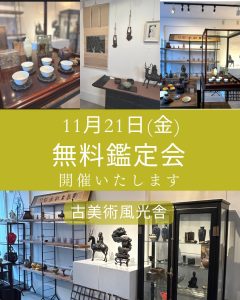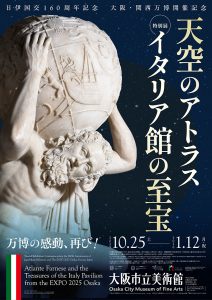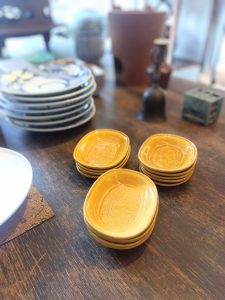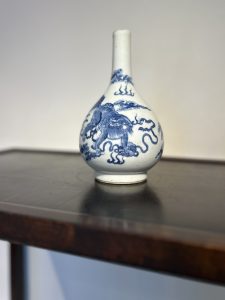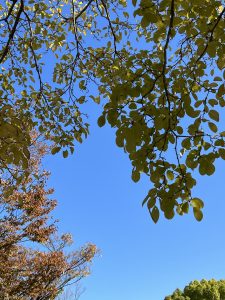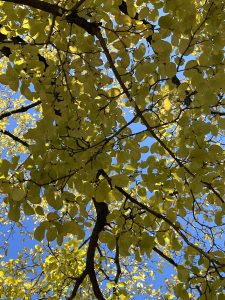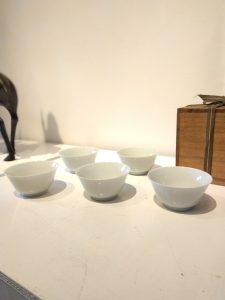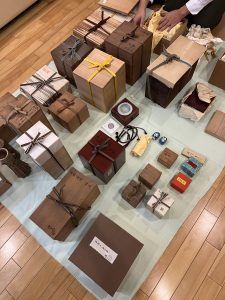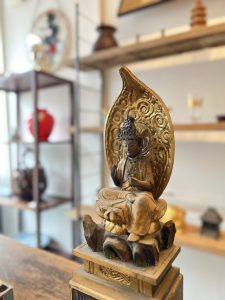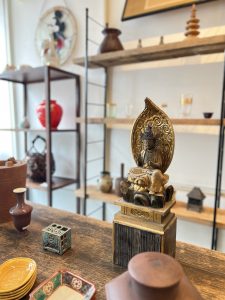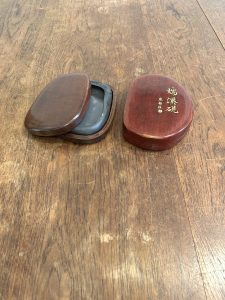先日、秋の桂離宮へ行って参りました。
お天気に恵まれたこと、紅葉がはじまっていたこと、などなどいろいろタイミングがよかったので、自分的にはまあまあの画像が撮れたような…(離宮内は撮影可能です)帰りの新幹線でも満足気に見直したりして笑。本日は画像多めでお届けしますので、秋の桂離宮楽しんでいただければと思います。
先日も天皇ご夫妻が御訪問なさっていたり、TVで放送していたりと皆さまご存知かと思われる「桂離宮」ですが、簡単に桂離宮を説明いたしますと…
まず、離宮とは皇居以外に設けられた宮殿のことでして、東京では赤坂離宮や芝離宮などもありますが、迎賓館や旧芝離宮恩賜公園も姿を変えて今にその面影を残しています。京都に現在残っている離宮は,西京区にある桂離宮と左京区にある修学院離宮の2つでして、京都の離宮は江戸時代では「山荘」や「別業」「茶屋」などと呼ばれていました。
明治維新以後,岩倉具視が発案した京都保存政策の一環として,建物が宮内省の管轄下に置かれ,離宮という名称が正式に使用されるようになるのですが、ちなみにあの二条城も明治16(1883)年頃には「二条離宮」と称して保存の対象となっていました。
桂離宮は後陽成天皇(ごようぜいてんのう)の異母弟である八条宮智仁親王(としひとしんのう,1579~1629)とその息子の智忠親王(としただしんのう,1619~62)によって,修学院離宮は後水尾上皇(ごみずのおじょうこう,1596~1680)によって造営されその後受け継がれ現在に至ります。桂離宮・修学院離宮の造営がはじめられた慶長から寛永の時期は(16世紀末~17世紀前半)、京都では公家や上層町衆を中心に、絢爛豪華な桃山美術とは趣を異にする平安時代の貴族が好んだ王朝文化に関心が高っておりました。
池に浮かべた船上で和歌を詠んだり、管弦を奏でたり、酒宴を設けるといった『源氏物語』などで描かれる王朝文化的な文化にとって郊外の山や川に臨んだ場所に造営された両離宮はまさに理想的な場所だったのでしょうね。
そのため、いずれの離宮も王朝文化を実践するため、数寄屋造(すきやづくり)の建物群のまわりには意匠を凝らした茶屋を配し、船遊びなどができる広大な苑池を造営しています。確かに桂離宮、どの茶亭にも船着き場がありましたね。
それでは桂離宮の世界へ入っていきましょう。
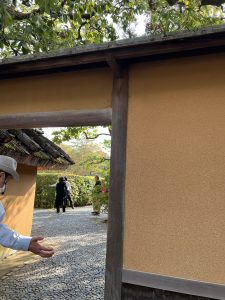
修学院離宮もそうなのですが、この入口の小ささが離宮という別世界へ一気に引き込まれます。この瞬間はたまりませんね。
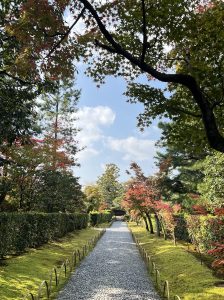

あれれこぼし
桂離宮の小道の特徴は、この「あられこぼし」。平たい小さな石を敷き詰め、自然で柔らかい印象に仕上げるのが特徴で、霰がこぼれ落ちたような風情のある庭園の小道を作ります。

御幸門
御幸門向こうにある表門(外と繋がっている門)は普段は閉ざされており、我々はそこから入ることはできません。天皇ご夫妻はこちらから入られたのでしょう。御幸門はあべまきの自然木の皮付の丸太に茅葺屋根のいたって素朴な造りでして、この御門からもわかるように、桂離宮は自然のままの造りをそのままとりこみ、細かなところまで趣深いところが満載であります。
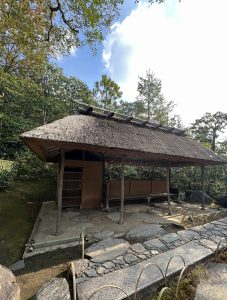
外腰掛
こちらも茅葺屋根を自然木の丸柱で支えているだけの造りなのですが、左の扉には雪隠(せっちん)があります。あくまでも「この外腰掛は丁寧な造りだよ」というアピールのための仮のものでして、実際には使用できないものでした。また、こちらの腰掛の前には島津家から献上された蘇鉄山があり、この奥の景色は見えないようにしていてワクワク感を演出しているようです。
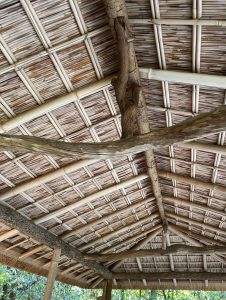
茅葺屋根の中の梁も自然の木のそのままの姿をつかっています。馴染んでいます。

州浜
どのお茶亭もこのように池に面しており、どのお茶亭もなんと船着き場があります。
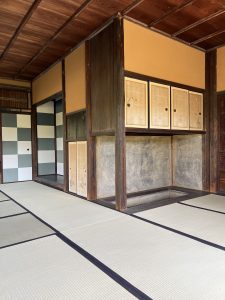
松琴亭
桂離宮のなかで最も格の高い茅葺入母屋造りの茶亭。青白の市松模様の襖が大胆なのですが、当時の発想にもかかわらず現在でも通じる斬新さです。越前和紙がつかわれているそうです。当初は加賀藩で作られていた加賀奉書が使われていたそうですが、もう加賀奉書を漉く人がもういなかったそうです。
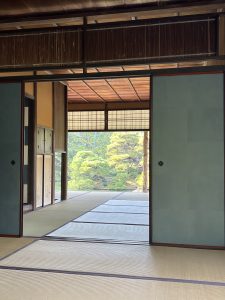
奥の床の間や茶室は少々見えにくいですが、なんとか…
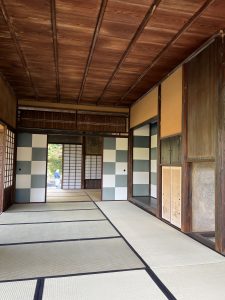
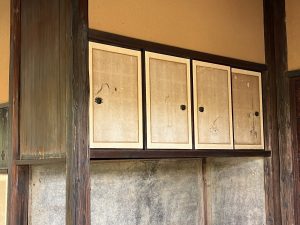
袋棚には狩野探幽の絵が描かれていますが、四匹の鳥が描かれています。

それぞれの茶亭などはこのような池にかかった橋を渡っていきます。
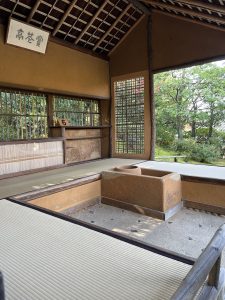
賞花亭
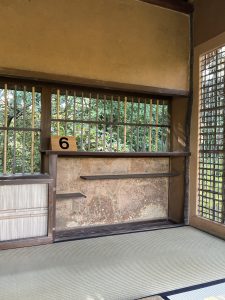
離宮の少し小高い所にある賞花亭。こちらは夏のお点前などをされていたのでしょう竹の連子窓がとても涼し気ですし、必要最小限の棚は段違いになった意匠です。

園林堂の橋を渡って
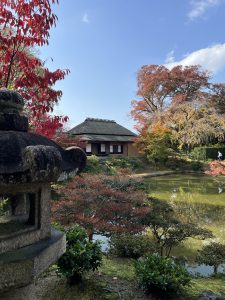
笑意軒
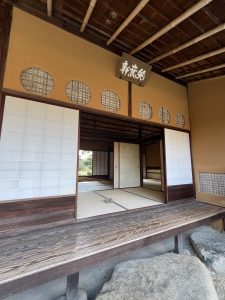
縁側などもあり田舎のお宅を彷彿される造りなのですが、腰高障子の上には六つの丸い下地窓が設けられているのですが、よく見ると下地の組み合わせをどれも変えています。内部は襖で仕切られているのですが、天井はひとつで繋がっていて、室内を広く見せる配慮でしょうか。つくばいには「浮月」という銘がついており、お月見の際はこの蹲に月が映っていたでしょうか。
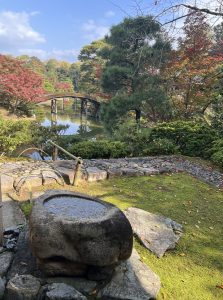
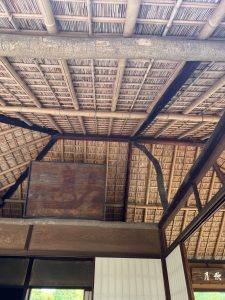
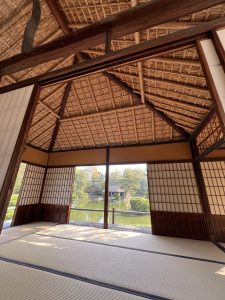
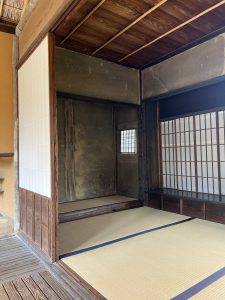
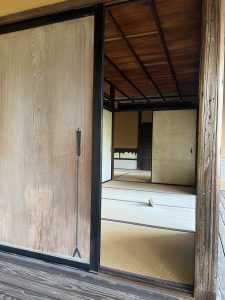
ひき手に注目。手前は杉戸の引き手は矢の形のもの。奥は櫂(かい)の形のものです。矢は流鏑馬神事の矢を表したのでしょうか、櫂は笑意軒の舟着場は入り江状の池は舟溜りとして使われたので「櫂」の形が選ばれたようです。
この建物の名前「笑」の意味は、こんなふうに諸所くすっと笑えるアイテムをが散りばめられているってところから来るのかなぁなんて思わせるところがたくさんでした。
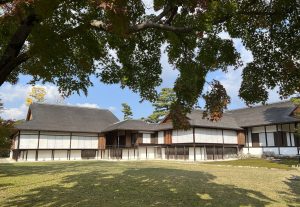
書院
残念ながらこちらは中を拝見することはできません…
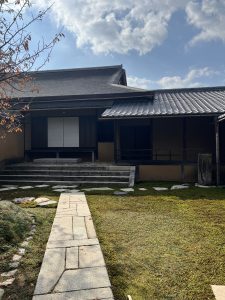
御輿寄
書院の玄関であり、この先の石段はを四段あがると一枚石の大きな沓脱があります。六人の沓を並べられたことから「六つの沓脱」というそうです。
どうやら書院をぬけますと、残念ながら離宮の見学は出口へ向かわなければならないようでして。
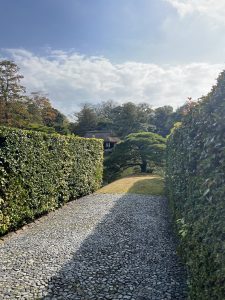
「あれ!もう出口?もう一度見学したいのだが…」という名残惜しい気持ちだけが残ってしまったので、これはいつしか再訪問するしかないのか。諸所に仕掛けられた趣深いひとつひとつをまた確かめたくなり、もう一度訪れたくなる桂離宮でありました。
それではごきげんよう(スタッフY)
The other day, I visited Katsura Imperial Villa in autumn.
The timing was perfect—great weather, the autumn leaves just starting to change—so I think I managed to get some decent photos… (Photography is allowed inside the villa grounds). I even found myself happily reviewing them on the Shinkansen ride back, lol. Today, I’ll be sharing quite a few images, so I hope you enjoy autumn at Katsura Imperial Villa.
As many of you likely know from recent visits by the Emperor and Empress or TV broadcasts, Katsura Imperial Villa is a well-known site. To briefly explain…
First, a “Rikyū” (離宮) refers to a palace established outside the Imperial Palace. In Tokyo, examples include Akasaka Palace and Shiba Rikyū, though the State Guest House and the former Shiba Rikyū Imperial Park now retain traces of their former forms. The two remaining imperial villas in Kyoto today are Katsura Imperial Villa in Nishikyo Ward and Shugakuin Imperial Villa in Sakyo Ward. During the Edo period, Kyoto’s imperial villas were called “mountain villas,” “summer residences,” or “tea houses.”
After the Meiji Restoration, as part of the Kyoto Preservation Policy proposed by Iwakura Tomomi, the buildings came under the jurisdiction of the Imperial Household Agency, and the name “detached palace” (rikyu) was formally adopted. Incidentally, even Nijo Castle was designated for preservation around 1883 (Meiji 16) under the name “Nijo Detached Palace.”
Katsura Imperial Villa was constructed by Prince Toshihito (1579–1629), the half-brother of Emperor Go-Yozei, and his son Prince Toshitada (1619–1662). Shugakuin Imperial Villa was built by Emperor Go-Mizunoo ( 1596–1680), and has been passed down to the present day. The Keichō to Kan’ei periods (late 16th to early 17th century), when construction of Katsura Imperial Villa and Shugakuin Imperial Villa began, saw a growing interest in Heian-period court culture among Kyoto’s nobility and upper merchant class. This culture differed in character from the splendid and luxurious Momoyama art.
For the courtly culture depicted in works like The Tale of Genji—where poetry was composed, music played, and banquets held aboard boats floating on ponds—the locations of both imperial villas, built overlooking mountains and rivers in the suburbs, were surely ideal.
Consequently, both palaces were designed to embody courtly culture. Around the sukiya-style buildings, intricately designed tea houses were placed, and vast garden ponds were created for activities like boat rides. Indeed, at Katsura Imperial Villa, every tea house had its own boat landing.
Now, let’s step into the world of Katsura Imperial Villa.
Like Shugakuin Imperial Villa, the smallness of this entrance instantly draws you into the separate world of the villa. This moment is simply irresistible.
Aragekoboshi
A defining feature of Katsura Imperial Villa’s paths is the “aragekoboshi.” Small, flat stones are laid to create a natural, soft impression, forming garden paths with the charming appearance of scattered hailstones.
Gokōmon Gate
The main gate (connecting to the outside) beyond the Imperial Gate is usually closed, and we cannot enter through it. The Emperor and Empress likely entered from this side. The Imperial Gate is a remarkably simple structure: round logs of natural wood with bark intact, topped with a thatched roof. As evident from this gate, Katsura Imperial Villa incorporates the natural landscape as it is, brimming with profound charm down to the smallest details.
Outdoor Bench
This structure also features a thatched roof supported solely by natural wooden round posts. However, the left door hides a latrine. This was merely a temporary feature meant to emphasize, “This outdoor bench is meticulously crafted,” and was not actually usable. Additionally, a sago palm tree, a gift from the Shimazu family, stands before this pavilion. The view beyond is deliberately obscured, seemingly designed to heighten anticipation.
The beams within the thatched roof also retain the natural form of the wood. They blend seamlessly.
Shuhama
Each tea pavilion faces a pond like this, and remarkably, each also has its own boat landing.
Shōkintei
The most prestigious thatched hip-and-gable tea house within Katsura Imperial Villa. Its bold blue-and-white checkered fusuma screens, despite their period design, retain a freshness that still resonates today. They reportedly use Echizen washi paper. Originally, Kaga hosho paper, produced in the Kaga domain, was used, but apparently, no one makes Kaga hosho anymore.
The alcove and tea room in the inner chamber are somewhat difficult to see, but somehow…
The bag shelf features a painting by Kano Tanyu depicting four birds.
Each tea house is accessed by crossing a bridge over a pond like this one.
Shōkatei
Shōkatei, situated on a slight elevation within the palace grounds. This was likely used for summer tea ceremonies. Its bamboo lattice windows feel wonderfully cool, and the minimalist shelves feature a staggered design.
Crossing the bridge at the Garden Pavilion
miling Intent Pavilion
It features a veranda, evoking the feel of a country home. Above the waist-high shoji screens are six round base windows, each with a uniquely arranged pattern upon closer inspection. The interior is partitioned by fusuma sliding doors, yet the ceiling remains continuous, perhaps a design choice to make the space feel more expansive. The tsukubai bears the inscription “Fugetsu” (Floating Moon). Did the moon reflect in this basin during moon-viewing gatherings?
Note the door handles. The front handle on the cedar door is arrow-shaped. The rear one is paddle-shaped. The arrow likely represents the arrows used in the Yabusame ritual, while the oar shape was chosen because the boat landing at Shōi-ken, with its inlet-like pond, was used as a boat dock.
The name of this building, “Shō” (meaning “smile”), seems fitting—there were many details that made me think it came from how items like these, scattered throughout, could make you chuckle.
Study
Unfortunately, we cannot view the interior here…
Mikoshi-yori
This is the entrance to the Study Hall. Ascending the four stone steps beyond leads to a large single-slab stone shoe-removal area. It is called the “Six Shoe-Removal Stones” because it was designed to accommodate six pairs of shoes.
It seems that after passing through the Study Hall, visitors must unfortunately proceed toward the exit to conclude their tour of the palace.
“What! Already the exit? I’d like to see it again…” Only a lingering sense of regret remained, meaning a return visit is inevitable. Katsura Imperial Villa is a place that makes you want to revisit, eager to rediscover each of its many charming features thoughtfully placed throughout.
Well then, take care (Staff Y)
*******************
ご実家の整理やお片付けなどをされている方のご相談などが多くございます。
お片付けなどくれぐれもご無理のないようになさってくださいませ。
風光舎では古美術品や骨董品の他にも絵画や宝石、趣味のお品など様々なジャンルのものを買受しております。
お片付けをされていて、こういうものでもいいのかしらと迷われているものでも、どうぞお気軽にご相談下さいませ。
また風光舎は、出張買取も強化しております。ご近所はもちろん、愛知県内、岐阜県、三重県その他の県へも出張いたします。
まずは、お電話お待ちしております。
愛知県名古屋市千種区姫池通
骨董 買取【古美術 風光舎 名古屋店】
TEL052(734)8444
10:00-18:00 OPEN
